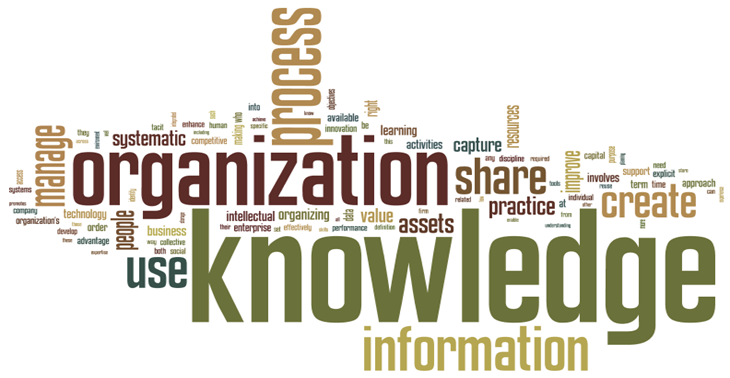KM Training and Professional Development Portal
KM Overview
Achieving Knowledge Mobilization through an Outcome-based KM Strategy
KM is the process of identifying, organizing, storing, and disseminating information within an organization.
The army employs KM to accomplish 4 organizational outcomes:
- Improve Decision Cycle Effectiveness
- Enhance Mission & Organizational Performance
- Create Agile Learning Organizations
- Facilitate Shared Understanding Through Collaboration
To accomplish the organizational outcomes above we must establish Effective KM Programs across the force. Effective KM Programs are characterized by a set of characteristics framed against DOTmLPF-P.

KM and collaboration work hand-in-hand to create and satisfy the thirst for information.
Doctrine
We have an established and integrated KM doctrine.
Organization
Our KM Infrastructure supports all echelons of our commands with CKOs leading Enterprise KM Programs, KM officers managing local KM programs and projects, KM Specialists providing the tactical skills on our KM Teams and KM Representatives serving as KM liaisons to every staff section and subordinate organization below the local program level.
A KM Advisory Committee designed to look at enterprise best practices and prioritize enterprise level resources.
KM Working Groups Chaired by the CKO or KMO and made up of KMRs focus on local solutions and services and share best practices between staffs and directorates.
Training
KM Onboarding provides a deliberate and tailored roadmap for our KM practitioners and reduces the time to competency of new KM employees.
Standardized KM Training at all levels ensures the KM workforce has the right people with the right skills, knowledge, and attributes to practice effective KM.
KM for the Workforce provides knowledge workers with skills and knowledge to perform their work, collaborate more effectively and use the KM tools available within their command.
An Army KM Qualification Course provides the mandatory credentialing needed to a professional KM workforce.
Material
An enterprise KM Support Contract provides the resources needed to create and implement a KM Program at echelon.
A centralized knowledge repository and resource renter help knowledge workers navigate to the right resources, just in time training and other useful content.
Leader Development & Education
Training prepares us for the known operational environment while education prepares us for the unknown changing environment. It focuses on developing KM leaders that can create and manage KM Programs.
A KM Professional Continuing Education Program ensure that our KM Practitioner become lifelong learners and continue to stay relevant in their fields.
Personnel
KM needs a dedicated Career Path and has created a Joint FED/DOD Working Group to develop the requirements for the career field and that working group we are working closely with the Office of Personnel Management to create a Federal and DOD career field.
KM Support Teams for COEs/MSOs
KM Force Structure Realignment for 2022-2028
Facilities
Facilities management, as applied to high-tech applications, includes on-site implementation of demanding technology, including copiers, printers, networks, servers, and other business-critical systems. The facilities analysis examines this complex structure and use to identify capability gaps and improve efficiencies.
Policy
TR 10-5/10-5-1
Inclusion in TRADOC Campaign Plan
KM Strategy, Implementation Plan
KM Standards (AEAS, CIP, Maturity Model)
Types of Knowledge
The definition of KM also includes three types of knowledge—tacit, implicit, and explicit knowledge. These types of knowledge are largely distinguished by the codification of the information.
- Tacit knowledge: This type of knowledge is typically acquired through experience, and it is intuitively understood. As a result, it is challenging to articulate and codify, making it difficult to transfer this information to other individuals. Examples of tacit knowledge can include language, facial recognition, or leadership skills.
- Implicit knowledge: Implicit knowledge is knowledge that is gained through incidental activities, or without awareness that learning is occurring. Some examples of implicit knowledge are knowing how to walk, run, ride a bicycle, or swim. It tends to exist within processes, and it can be referred to as “know-how” knowledge.
- Explicit knowledge: Explicit knowledge is captured within various document types such as manuals, reports, and guides, allowing organizations to easily share knowledge across teams. This type of knowledge is perhaps the most well-known and examples of it include knowledge assets such as databases, white papers, and case studies. This form of knowledge is important to retain intellectual capital within an organization as well as facilitate successful knowledge transfer to new employees.

Effective KM can be looked at in three broad practices.
- Knowledge Creation: Organizations identify and document any existing or new knowledge that they want to circulate across the company.
- Knowledge Storage: An information technology system is typically used to host organizational knowledge.
- Knowledge Sharing: Exchange of ideas and information communicated across the organization.
Examples of KM Tools
- Document management systems act as a centralized storage system for digital documents, such as PDFs, images, and word processing files. These systems enhance employee workflows by enabling easy retrieval of documents, such as lessons learned.
- Content management systems (CMS) are applications which manage web content where end users can edit and publish content. These are commonly confused with document management systems, but CMSs can support other media types, such as audio and video.
- Intranets are private networks that exist solely within an organization, which enable the sharing of enablement, tools, and processes within internal stakeholders.
- Wikis can be a popular KM tool given its ease of use. They make it easy to upload and edit information, but this ease can lead to concerns about misinformation as workers may update them with incorrect or outdated information.
- Data warehouses aggregate data from different sources into a single, central, consistent data store to support data analysis, data mining, artificial intelligence (AI), and machine learning.
KM Strategies
While KM solutions can be helpful in facilitating knowledge transfer across teams and individuals, they also depend on user adoption to generate positive outcomes. As a result, organizations should not minimize the value of human elements that enable success around KM.
- Organizational Culture: Management practices will affect the type of organization that executives lead. Managers can build learning organizations by rewarding and encouraging knowledge sharing behaviors across their teams. This type of leadership sets the groundwork for teams to trust each other and communicate more openly to achieve business outcomes.
- Communities of practice: Centers of excellence in specific disciplines provide employees with a forum to ask questions, facilitating learning and knowledge transfer. In this way, organizations increase the number of subject matter experts in a given area of the organization, reducing dependencies on specific individuals to execute certain tasks.

At TRADOC HQ a group of KM professionals with a passion for continuous learning share knowledge and experiences to improve TRADOC processes.
KM Applications
Armed with the right tools and strategies, KM practices have created success in specific applications, such as:
- Enabling Knowledge Mobilization. As KM practitioners, it is our job to create opportunities for these three types of interactions.
- People to people (P2P) Think connecting people around meaningful content is constructive conversations that improve situational understanding, increase learning, or make teams and organizations for effective.
- People to Systems (P2S) Think of interfacing with google or amazon.com or your local online repository.
- Systems to Systems to People (S2S2P) Think of a dashboard or common operating picture that helps decision makers see data and information from authoritative sources to improve decision making.
- Onboarding employees: KM systems help to address the huge learning curve for new hires. Instead of overwhelming new hires during their initial weeks, continually support them with knowledge tools that will give them useful information at any time.
- Day-to-day employee tasks: Enable every employee to have access to accurate answers and critical information. Access to highly relevant answers at the right time, for the right person, allows workforces to spend less time looking for information and more time on activities that drive business.
- Self-serve customer service: Customers repeatedly say they’d prefer to find an answer themselves, rather than pick up the phone to call support. When done well, a KM system helps businesses decrease customer support costs and increase customer satisfaction.
Benefits of KM
Organizations experience a number of benefits when they embrace KM strategies. Some key advantages include:
- Improved Decision Cycle Effectiveness: KM systems arm individuals and departments with knowledge. By improving accessibility to current and historical enterprise knowledge, your teams can upskill and make more information-driven decisions that support business goals.
- Mission & Organizational Performance: KM practices help by creating efficiency and reducing duplication of effort which improves organizational performance.
- Agile Learning Organizations: Agile learning organizations produce value by using dynamic and iterative techniques, such as collaboration, faster design solutions, feedback, and change to create progressive learning organizations.
- Shared Understanding Through Collaboration: KM practices and organizational cultures work together to build trust among team members. These practices provide more transparency among workers, creating more understanding and alignment around common goals. Engaged leadership and open communication create an environment for teams to embrace innovation and feedback. KM Increases collaboration and communication.
- Identification of skill gaps: When teams create relevant knowledge around implicit or tacit knowledge or consolidate explicit knowledge, it can highlight gaps in core competencies across teams. This provides valuable information to management to form new organizational structures or hire additional resources.
- Maintains enterprise knowledge: If your most knowledgeable employees left tomorrow, what would your business do? Practicing internal KM enables businesses to create an organizational memory. Knowledge held by your long-term employees and other experts, then make it accessible to your wider team.
- Operational efficiencies: KM systems create a go-to place that enable knowledge workers to find relevant information more quickly or to connect with subject matter experts faster. This, in turn, reduces the amount of time on research, leading to faster decision-making and cost-savings through operational efficiencies. Increasing productivity not only saves time, but also reduces costs.
- Data Security: KM through its content management and data security approaches enable organizations to customize permission control, viewership control and the level of document-security to ensure that information is shared only in the correct channels or with selected individuals. Give your employees the autonomy to access knowledge safely and with confidence.

In conclusion, there are many benefits to utilizing KM techniques and tools, both to you and your organization. When you can save yourself time and effort it’s always a win! This KM Overview puts you on the pathway to seeing the benefits of good KM practices!